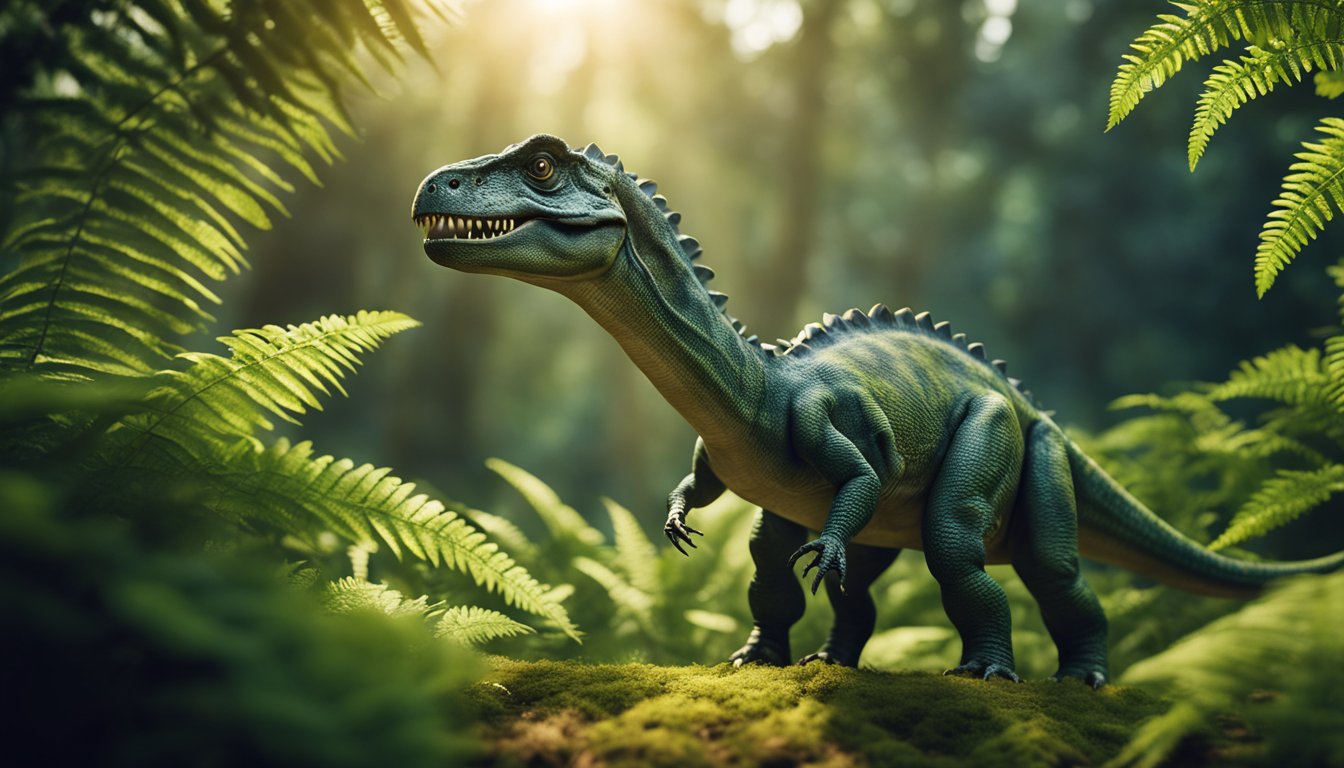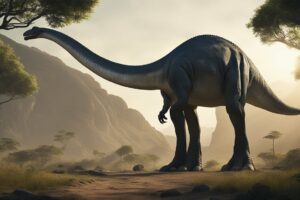Meet Sarcosuchus, the massive prehistoric crocodile that roamed the earth during the Cretaceous period.
With a length of up to 40 feet and weighing over 8 tons, this apex predator was one of the largest crocodiles to have ever existed.
Discovering Sarcosuchus
Learn about the fascinating discovery of Sarcosuchus fossils in Niger, Africa, and how scientists were able to reconstruct the massive creature’s appearance and behavior.
Sarcosuchus’ Unique Features
Explore the unique physical characteristics that made Sarcosuchus a formidable predator, including its massive jaws, sharp teeth, and armored skin.
Life in the Cretaceous
Step back in time to the Cretaceous period and learn about the other creatures that shared the earth with Sarcosuchus, including dinosaurs and other prehistoric reptiles.
Sarcosuchus’ Legacy
Discover how the discovery of Sarcosuchus has contributed to our understanding of prehistoric life and continues to inspire scientists and researchers today.
Fun Facts About Sarcosuchus
Did you know that Sarcosuchus
Sarcosuchus, the giant crocodile of the Cretaceous, is a creature that captures the imagination with its sheer size and ferocity.
This prehistoric reptile lived over 112 million years ago and was one of the largest crocodile-like reptiles that ever lived.
The name Sarcosuchus means “flesh crocodile,” a fitting name for a creature that was a top predator in its environment.

Sarcosuchus was a formidable creature that could grow up to 40 feet long and weigh up to 8 tons.
Its massive jaws were lined with over 100 teeth, and it had a bite force of over 18,000 newtons, making it one of the most powerful biters of all time.
The discovery of Sarcosuchus fossils has allowed scientists to learn more about this fascinating creature and its place in the prehistoric world.
Despite its fearsome appearance, Sarcosuchus was not invincible.
The changing environment and competition from other predators eventually led to its extinction.
However, the legacy of this giant crocodile lives on, and its fossils continue to provide valuable insights into the world of the Cretaceous period.
Uncovering the Past: Discovery and Fossils
Sarcosuchus Imperator, also known as the “super croc,” was a giant crocodile-like creature that roamed the Earth during the Cretaceous period.
The discovery of Sarcosuchus was a groundbreaking moment in the world of paleontology, and it has since become one of the most fascinating and mysterious creatures of the prehistoric world.
First Finds and Excavations
The first discovery of Sarcosuchus Imperator was made in 1964 by a French paleontologist named Albert-Félix de Lapparent, who was working in the Sahara Desert in Niger.
He found a partial skull of an enormous crocodyliform while he was mapping a remote section of the Ténéré Desert.
The discovery was named Sarcosuchus Imperator, and it was the first time that anyone had seen such a massive creature.
Later, in 1997, a team of American paleontologists led by Paul Sereno discovered more fossils of Sarcosuchus Imperator.
They found a nearly complete skull, which allowed them to reconstruct the creature’s appearance and behavior.
The fossils were found in the Elrhaz Formation in Niger, which is known for its abundant dinosaur fossils.
Fossil Analysis and Reconstruction
The fossils of Sarcosuchus Imperator were carefully analyzed and reconstructed to give us a better understanding of what this giant creature looked like.
The skull was the most well-preserved part of the fossil, and it was used to estimate the size of the creature.
From the skull, scientists were able to determine that Sarcosuchus Imperator was about 40 feet long and weighed around 8 tons.
The reconstruction of the skeleton also revealed that Sarcosuchus Imperator had a unique body structure that allowed it to be an efficient predator.
It had a long and broad snout that was filled with sharp teeth, which it used to catch and eat its prey.
The creature’s powerful jaws were also capable of exerting a force of up to 18,000 pounds, making it one of the strongest bite forces of any animal, living or extinct.
In conclusion, the discovery of Sarcosuchus Imperator has provided us with a glimpse into the prehistoric world and has helped us better understand the diversity of life that existed during the Cretaceous period.
The fossils of this giant creature have allowed us to reconstruct its appearance and behavior, and have given us a better understanding of how it lived and interacted with its environment.
The Life of Sarcosuchus

Sarcosuchus was a giant crocodyliform that lived during the Early Cretaceous period, approximately 112 million years ago.
It was a predator that roamed the land and waterways of what is now Africa and South America.
Sarcosuchus was not just a bigger version of today’s crocodiles, but a unique predator with its own set of hunting techniques and adaptations.
Habitat and Environment
Sarcosuchus lived in a warm and humid environment, with a thriving marine ecosystem and interior streams.
It inhabited the Ténéré Desert, an area of the modern Sahara desert, which was then a lush and tropical region.
Sarcosuchus was an ambush predator, hiding in the water and waiting for its prey to come close enough to strike.
Diet and Hunting Techniques
Sarcosuchus was a piscivore, which means it primarily ate fish. However, it was also a generalized predator, meaning it ate a wide variety of prey.
Sarcosuchus had a unique hunting technique, where it would use its powerful jaws to create a vacuum in the water, sucking in prey like a vacuum cleaner.
It had a long and narrow snout, which helped it to catch fish and other small prey.
Growth and Development
Sarcosuchus was one of the largest crocodile-like reptiles that ever lived, with an estimated length of up to 40 feet and a weight of up to 8 tons.
It had a slow growth rate, taking up to 50 years to reach its full size.
Sarcosuchus was also known for its longevity, with some individuals living up to 100 years.
Sarcosuchus was a fascinating predator that lived during a time when the world was very different from what we know today.
It was a top predator in its environment, with a unique set of adaptations that allowed it to thrive.
Despite its size and power, Sarcosuchus was not invincible, and it eventually went extinct along with many other prehistoric creatures.
Comparing Giants: Sarcosuchus and Its Contemporaries

Sarcosuchus is one of the largest crocodile-like reptiles that ever lived, but how does it compare to other giants of the past and present?
In this section, we will compare Sarcosuchus to modern crocodiles and its prehistoric contemporaries.
Sarcosuchus vs. Modern Crocodiles
Modern crocodiles are impressive creatures, but they are no match for the sheer size of Sarcosuchus.
The largest crocodile alive today is the saltwater crocodile, which can reach lengths of up to 23 feet and weigh over a ton.
In contrast, Sarcosuchus was estimated to be around 40 feet long and weighed up to 8 metric tons.
That’s nearly four times the length and eight times the weight of a saltwater crocodile!
Another difference between Sarcosuchus and modern crocodiles is their snouts.
Sarcosuchus had a long and narrow snout that was filled with teeth, while modern crocodiles have broader snouts that are more suited for catching fish.
This suggests that Sarcosuchus was a predator that hunted larger prey, such as dinosaurs and other reptiles.
Sarcosuchus and Dinosaurs
Sarcosuchus lived during the Cretaceous period, around 112 to 93 million years ago.
At this time, the world was dominated by dinosaurs, including giant theropods like Spinosaurus.
While Sarcosuchus was not a dinosaur, it coexisted with them and likely preyed on smaller species.
One of Sarcosuchus’ closest relatives was Deinosuchus, a giant crocodilian that lived in North America during the Late Cretaceous period.
Deinosuchus was similar in size to Sarcosuchus and had a similar diet, but it had a shorter and wider snout that was better suited for crushing bones.
Fun Facts
- Sarcosuchus was not the only crocodile-like reptile to live during the Cretaceous period.
Another giant crocodilian, Gharialosuchus, also lived at this time.
- Despite its size, Sarcosuchus was not the largest reptile to ever live.
That title goes to the marine reptile, Liopleurodon, which could reach lengths of up to 50 feet.
- Sarcosuchus was not the only predator to hunt dinosaurs. Some theropods, such as Tyrannosaurus rex, also preyed on smaller dinosaurs.
In conclusion, Sarcosuchus was a truly impressive creature that dominated the rivers and swamps of the Cretaceous period.
Its sheer size and powerful jaws made it a formidable predator that likely preyed on a variety of animals, including dinosaurs.
While modern crocodiles are impressive in their own right, they pale in comparison to the giant crocodilians of the past.
Frequently Asked Questions

How big was the Sarcosuchus compared to modern-day crocodiles?
Sarcosuchus was an enormous crocodile-like reptile that lived during the Cretaceous period and is estimated to have reached up to 40 feet (12 meters) in length and weighed up to 8 tons.
This makes it one of the largest crocodile-like reptiles ever to have lived on Earth, far larger than any modern-day crocodile.
What kind of habitat did the Sarcosuchus live in during the Cretaceous period?
Sarcosuchus lived in the freshwater rivers and lakes of what is now Africa and South America during the Cretaceous period, around 112 million years ago.
At the time, the climate was much warmer and wetter than it is today, and the landscape was covered in dense forests and swamps.
Can you tell me about the diet of the Sarcosuchus and how it hunted its prey?
Sarcosuchus was a fierce predator that hunted small dinosaurs and other reptiles that lived in and around the rivers and lakes where it lived.
Its long, powerful jaws were lined with rows of sharp teeth that it used to seize and crush its prey.
Sarcosuchus was an ambush predator, lying in wait for its prey to come close before striking with lightning-fast speed.
How do we know about the existence of Sarcosuchus and what do its fossils tell us?
We know about Sarcosuchus from the fossils that have been discovered over the years.
These fossils have provided us with a wealth of information about the anatomy, behavior, and habitat of this prehistoric reptile.
By studying the fossils, scientists have been able to reconstruct the appearance of Sarcosuchus and learn about its lifestyle.
What are the distinctive features that differentiate Sarcosuchus from other prehistoric crocodiles?
Sarcosuchus was distinguished from other prehistoric crocodiles by its enormous size and its long, narrow snout.
Its snout was lined with rows of sharp teeth that it used to seize and crush its prey.
Sarcosuchus also had a pair of bumps on the top of its head that may have been used for display or as a way of identifying other members of its species.
How did the Sarcosuchus compare in size and behavior to the Spinosaurus?
Sarcosuchus was similar in size to the Spinosaurus, another prehistoric predator that lived during the same period.
However, while the Spinosaurus was a land-dwelling dinosaur, Sarcosuchus was a freshwater reptile that lived in the rivers and lakes of Africa and South America.
Both animals were fierce predators that hunted other animals for food, but they had different lifestyles and habitats.






